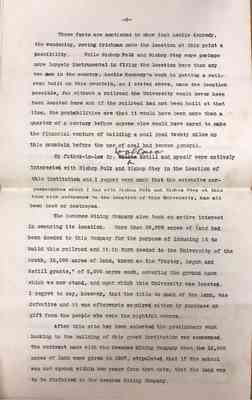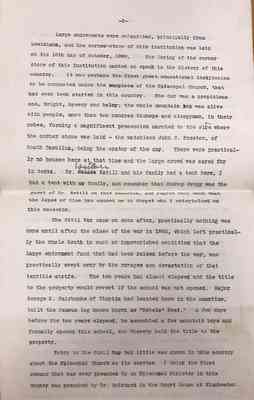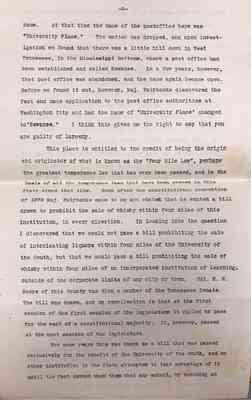Pages
1
The early history of the University of the South and Sewanee, is so intimately associated, with that of the early history of Tennessee Coal, Iron and Railroad Company, that I will be pardoned for briefly referring to some facts in this connection. In 1851 a roving Irishman by the name of Leslie Kennedy, in wandering through these mountains, became very much impressed with the quantity and quality of the coal around Sewanee and especially around Tracy City. Kennedy went to Nashville and interested a lawyer, Col. W. N. Bilbo, in a scheme to acquire these lands and build a coal road from the junction of the Nashville & Chattanooga road at Cowan to this point and beyond. Col. Bilbo went to New York and interested Mr. Samuel F. Tracy of New York City, and some other moneyed men in the proposed enterprise. A legislative charter was acquired in 1852 for the Sewanee Mining Company, for the purpose of mining and selling coal. The money was almost entirely raised in New York, and the railroad commenced in 1853. In 1856 it was completed to what was know as the Coal Bank, which is about two miles from Sewanee on the road to Tracey City. Subsequently, the road was extended to Tracy City and finished to that point in the fall of 1858. Litigation ensued between the contractor and the owners of the property which resulted in two sales of the entire property, one under a judgment for the State Court of Tennessee and one under a Federal Judgement in the United States Court. The Tennessee creditors, headed by Col. B. F. McGhee of Winchester who was the contractor, bought the property at Tennessee Court sale. One C. A. Proctor, representing the New York creditors bought in the property at the Federal Court sale. Soon after this the Civil War came on and nothing was done with these conflicting claims until the early spring of 1865, when I went to New York as the representative of the Tennessee purchasers and made a settlement and compromise with the New York purchasers, by which it was agreed that the New York purchasers should take $220,000 of bonds on the property and turn it over to the Tennessee purchasers.
2
These facts are mentioned to show that Leslie Kennedy, the wondering, roving Irishman made the location at this point a possibility. While Bishop Polk and Bishop Otey were perhaps more largely instrumental in fixing the location here than any two men in the country, Leslie Kennedy's work in getting the railroad built up this mountain, as I stated above, made the location possible, for without a railroad the University would never have been located here and if the railroad had not been built at that time, the probabilities are that it would have been more than a quarter of a century before anyone else would have dared to make the financial venture of building a coal road twenty miles up this mountain before the use of coal had become general.
My father-in-law Dr. Wallace Estill and myself were actively interested with Bishop Polk and Bishop Otey in the location of this institution and I regret very much that the extensive correspondence which I had with Bishop Polk and Bishop Otey at this time with reference to the location of this University, has all been lost or destroyed.
The Sewanee Mining Company also took an active interest in securing its location. More than 50,000 acres of land had been deeded to this Company for the purpose of including it to build this railroad and it in turn deeded to the University of the South, 15,000 acres of land, known as the "Porter, Logan and Estill grants," of 5,000 acres each, covering the ground upon which we now stand, and upon which this University was located. I regret to say, however, that the title to much of the land, was defective and it was afterward acquired either by purchase or gift from the people who were the rightful owners.
After this site had been selected the preliminary work looking to the building of this great institutions was commenced. The contract made with the Sewanee Mining Company when the 15,000 acres of land were given in 1857, stipulated that if the school was not opened within ten years from that date, that the land was to be forfeited to the Sewanee Mining Company.
3
Large endowments were subscribed, principally from Louisiana, and the corner-stone of this institution was laid on the 10th day of October, 1860. The laying of the corner stone of this institution marked an epoch in the history of this country. It was perhaps the first great educational institution to be conducted under the auspices of the Episcopal Church, that had ever been started in this country. The day was a propitious one, bright, breezy and balmy: the whole mountain top was alive with people, more than two hundred bishops and clergymen, in their robes, forming a magnificent procession marched to the site where the corner stone was laid - the matchless John C. Preston, of South Carolina, being the orator of the day. There were practically no houses here at that time and the large crowd was cared for in tents. Dr. Wallace? Estill and his family had a tent here, I had a tent with my family, and remember that Bishop Gregg was the guest of Dr. Estill on that occasion, and regret very much that the lapse of time has caused me to forget who I entertained on this occasion.
The Civil War came on soon after, practically nothing was done until after the close of the war in 1865, which left practically the whole South in such an impoverished condition that the large endowment fund that had been raised before the war, was practically swept away by the ravages and devastation of that terrible strife. The ten years had almost elapsed and the title to the property would revert if the school was not opened. Major George R. Fairbanks of Florida had located here in the meantime, built the famous log house known as "Rebel's Rest." A few days before the ten years elapsed, he assembled a few mountain boys and formally opened this school, and thereby held the title to the property.
Prior to the Civil War but little was known in this country about the Episcopal Church or its service. I think the first sermon that was ever preached by an Episcopal Minister in this County was preached by Dr. Quintard in the Court House at Winchester.
4
An amusing incident occurred at this service. A worshipping the congregation had never before seen a minister in his ministerial robes. When Dr. Quintard got up into the judge's stand in the Court House and began his service, a respectable, honest old shoemaker who had gone to the service was seen to get up and motion to his daughter and leave the house. When asked, after the service, why he did so, his reply was, that although he was ignorant and had never seen much of the world and didn't know much, that his children had been too well raised to see a man preach in his night clothes.
Soon after this time, the first class was confirmed by Dr. Quintard in Winchester. The hidebound Puritanical blue stocking ideas of that day were very much more pronounced than they are now. Dr. James R. Graves, one of the leading Baptist divines of that day, publisher of the Baptist Reflector, and a man who had the great controversy with Parson Brownlow, heard of Bishop Quintard's doctrinal sermon as he called it, and at once advertised the fact extensively that on a certain Sunday he would reply to Dr. Quintard's sermon. An immense audience was assembled in the Mary Sharp College at Winchester, which was then conducted by his brother, Rev. Z. C. Graces as a Baptist Female School. Dr. Graves spoke four hours and ten minutes, making a very violent and denunciatory speech, to which Dr. Quintard paid no attention, and there the incident dropped.
After the close of the Civil War, I became over of the Sewanee Mines and commenced the work of rebuilding and rehabilitating it's property, and right here I went to bring charge of larceny against the University of the South. One of the first things I did was to attempt to get the name of Tracy City changed to Sewanee, for the reason that it had been chartered as the Sewanee Mining Company - the coal had been named Sewanee Coal, and the mines were known as the Sewanee Mines, and we thought, very properly, that the name of the place should be Sewanee. When we applied to the Post Office Department for a change of the name from Tracy City to Sewanee, we were advised that there was already one Sewanee in Tennessee, and that we could not get the
5
name. At the time the name of the postoffice here was "University Place." The matter was dropped, and upon investigation we found that there was a little hill down in West Tennessee, in the Mississippi bottom, where a post office had been established and called Sewanee. In a few years, however, that post office was abandoned, and the name again became open. Before we found it out, however, Maj. Fairbanks discovered the fact and made application to the post office authorities at Washington City and had the name "University Place" changed to "Sewanee." I think this gives me the right to say that you are guilty of larceny.
This place is entitled to the credit of being the origin and originator of what is known as the "Four Mile Law", perhaps the greatest temperance law that has ever been passes, and is the basis of all the temperance laws that have been passed in this State since that time. Soon after the constitutional convention of 1870 Maj. Fairbanks came to me and stated that he wanted a bill drawn to prohibit the sale of whisky within four miles of this institution, in ever direction. In looking into the question I discovered that we could not pass a bill prohibiting the sale of intoxicating liquors within four miles of the University of the South, but that we could pass a bill prohibiting the sale of whisky within four miles of an incorporated institution of learning, outside of the corprate limits of any city or town. Col. H. R. Moore of this County was then a member of the Tennessee Senate. The bill was drawn, and my recollection is that at the first session of the first session of the legislature it failed to pass for the want of constitutional majority. It, however, passed at the next session of the legislature.
For some years this was known as a bill that was passed exclusively for the benifit of the University of the South, and no other institution in the state attempted to take advantage of it until the fact dawned upon them that any school, by becoming an




